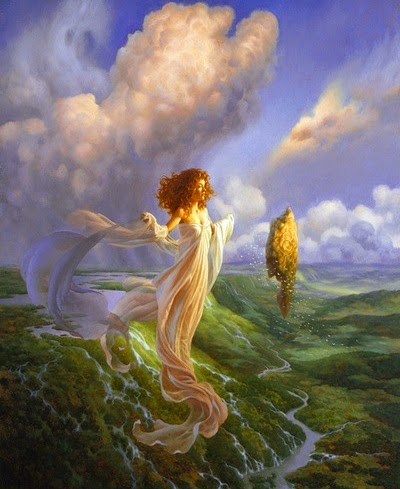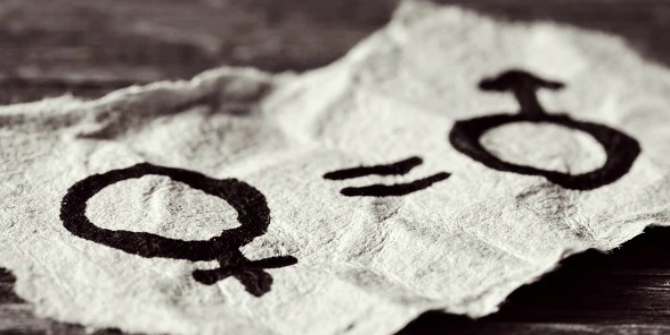GENDER ROLES IN ORIGIN STORIES
Our group looked at two different origin myths to analysis the role of gender. In the first myth, “Brahma Creates the World”, we are told of a male deity Brahma who is known for creating the world. He creates feelings, qualities, demons, people, etc. There is a picture in the myth which shows another male deity Vishnu laying on a serpent, being massaged by his wife Lakshmi. From his bellybutton grows a stem from which Brahma is born. Vishnu is known as the lord of creation while Brahma is the creator of the world. From this story we can see the role of each gender. There is little mention of women in the origin story, the only mention shows Lakshmi massaging her husband Vishnu. From this we can see that the role of women is to serve their husband and family only. The creation and maintenance of the world is left for the men. There are still many places where people still believe that the roles of women relate to their family only. Some countries that still have people who adhere to this thought are India and Pakistan. This makes sense as that is the creation place of this myth.
The second myth that we analyzed is “Theogony”. It is a Greek origin myth portrayed in poem format. It starts with Chaos rising first, followed by Gaia, Tartarus, and Eros. The first, Chaos, is the goddess of air, and the second, Gaia, is seen as mother Earth. From this we can see how the role of gender played in Greek origin myths. We can see how important women were in Greek mythology just by the fact that it was a woman who first came into existence. Other gods like Zeus are born from Gaia, and there are both positively and negatively portrayed gods. Examples of negatively portrayed gods are Uranus and Cronus who prevented their children from being born because they were destined to overthrow them. Gods like Zeus are portrayed positively, who saved his siblings from the hands of Cronus. Goddesses on the other hand were mainly portrayed positively, showing their purity.

Rohit, Chaos, 01-Jan-1970. [Online]. Available: http://01greekmythology.blogspot.com/2013/09/chaos.html. [Accessed: 20-Jul-2020].
From this we can see how different these two myths show the gender roles. In Hinduism, a woman is seen as the caretaker of the family, with no relation to creating the world, while in Greek culture a woman is seen as the creator of the universe.
Sexism is slowly being eliminated, with women having many more rights and responsibilities that they didn’t have before. However it still exists in places like workplaces, where men get paid more to do the same job as a women. This all has begun with the help of the myths, which mostly show men as superior to women. Hopefully we are able to completely eliminate sexism as soon as we can, and eliminate the stereotype that women are weaker than men.

Chinkin, Christine. New European Recommendation Aims to Prevent and Combat Sexism, 14 May 2019, blogsmedia.lse.ac.uk/blogs.dir/111/files/2019/05/Combating_Sexism_wp.jpg. [Accessed: 20-Jul-2020].
WORLDVIEWS
From the Brahma myth, we can see the worldview of Hindus. In the myth, it shows karma as the reason for the destruction of the world. If a person does a good deed, they will get good karma, while committing a crime or wrong actions will lead to bad karma. With Moksha (escaping rebirth) being the main goal of Hindus, it can only be achieved if a person hasn’t accumulated any bad karma. This is where we can see the link to the present day worldview of Hindus, where people still follow this karma system in order to obtain Moksha. The destruction of the world occurs when there is more bad than good karma, and the newly created world starts with little to no bad karma. During creation, it is said that demons and darkness come from Brahma’s thighs where as gods and light come from his mouth. A person’s mouth is higher than their thighs, and this shows the strength or power of each. The central theme of Indian myths is Light vs Darkness, and this can also be tied in with karma. Good deeds can be denoted as light and bad deeds with darkness. Light is more powerful and because of this good deeds will allow for a person to achieve Moksha. This shows the thinking of Hindu’s, and it all traces back to Brahma.

Heald, J. (n.d.). Black vs White Wolf [Digital image]. Retrieved July 20, 2020, from https://www.cultyourbrand.com/wp-content/uploads/Black-Vs-White-Wolf.jpg
The Jataka tales show the worldviews of the Buddha. In each tales, the Buddha incarnates into a different person or even animal. This shows the Buddha believe in the cycle of rebirth. Buddha also believe in the ideas of karma and Moksha, parallel to Hinduism. They think that actions cause a person to accumulate karma which decides if they obtain Moksha or not. These ideas of Buddhism and Hinduism are very similar due to the geographical area each are from. Both Buddhism and Hinduism originate in or around the country of India, and because of this, there were interactions and sharing of values and beliefs. Because of this, the ideas of these two groups are very similar.
BIBLIOGRAPHY
-D. L. Ashliman, “The Jataka Tales,” Jataka Tales, 2002. [Online]. Available: https://www.pitt.edu/~dash/jataka.html. [Accessed: 20-Jul-2020].
-“Theogony,” Wikipedia, 07-Jul-2020. [Online]. Available: https://en.wikipedia.org/wiki/Theogony. [Accessed: 20-Jul-2020].
-Myths from the myth library on D2L
Leave a Reply
You must be logged in to post a comment.